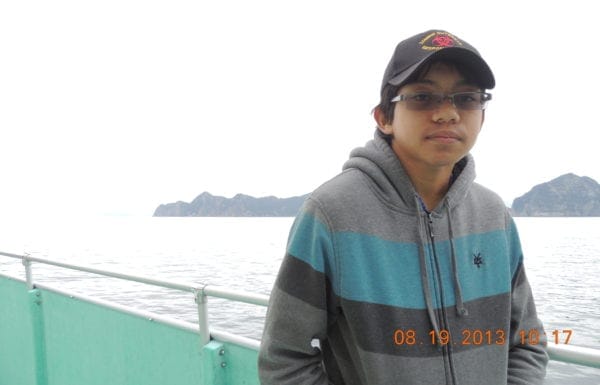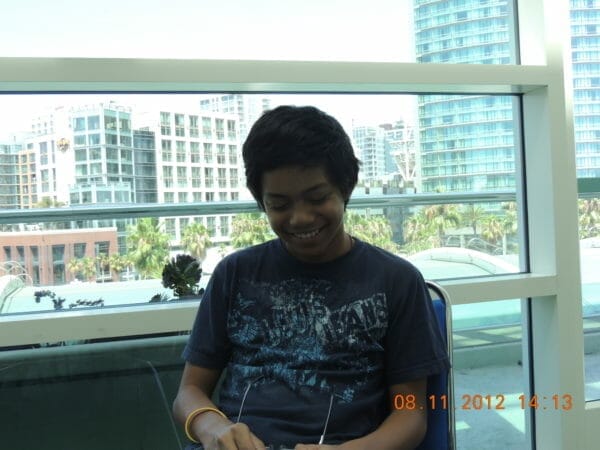
USA – -(AmmoLand.com)- Eli Pagunsan’s life changed forever when California officials branded him as a potential school shooter.
It’s not easy for Eli Pagunsan to talk about the ordeal that began seven years ago, when he was a high school freshman in Riverside County, California. His life was destroyed. He briefly considered suicide as a way out.
When he looks back, the now 22-year-old feels a mix of “anger, anguish, and fear.”
“There’s a part of me that needs this story to be told,” he said. “I’ve been trying to tell people about it. I didn’t understand that what happened to me was wrong until I went to therapy.”
Life has never been easy for Pagunsan. He has always been an outsider and somewhat of an introvert. His parents immigrated from the Philippines. Pagunsan was born in Arkansas. He says he grew up the victim of frequent abuse, which was meted out by his father.
“We’ve reconciled now. I’ve forgiven him, but I remember whenever he was mad at us, he’d strip us naked and beat us with whatever was closest – a vacuum pipe, electrical cord or belt,” Pagunsan said.
At one point, he said, his father made him tell his teachers he was “worthless,” and that he wouldn’t be coming to school anymore.
After his parents divorced, an ex-Army officer who was helping raise Pagunsan told him he would either be a heroin addict or shot by police, and that he would be a “juvenile delinquent.”
All three assessments were wrong.
As a young man, Pagunsan found solace in reading, video games, and history.
“I used to be a big fan of World War II films like ‘Band of Brothers’ and ‘The Pacific,’ he said. “I played a lot of ‘Medal of Honor: Pacific Assault.’ I found out that my family fought as guerillas against the Japanese, and I’m very proud of that.”
Pagunsan’s great-grandfather was a carpenter on Luzon when the Japanese invaded.
“He had a choice to either run or fight. He fought with the Americans. He was captured and survived the Bataan Death March. He lived until 1978 when he died of lung cancer,” Pagunsan said.
While most kids his age were socializing and interacting with others, Pagunsan was playing video games, reading in the library, or writing.
He joined a writing club when he was only 12 years old.
“I still get a weird, cathartic feeling creating characters that are based off of experiences I have had,” he said. “I get satisfaction from writing – being able to improve upon it feels good.”
All of Pagunsan’s hobbies and interests would play a role in what was to come.
Potential Shooter!?
Rather than becoming a juvenile delinquent as the Army officer had predicted, Pagunsan gravitated toward law enforcement.
He became a police explorer – a hands-on program for kids interested in making law enforcement a career, which offers training, competitions, character development, and physical fitness.
One evening in 2014, Pagunsan received a call from his police explorer instructor – a sworn law enforcement officer.
“The first thing he asked me was, ‘Are you going to shoot up your high school?’” Pagunsan recalled.
The instructor ordered Pagunsan and his mother to report to his school’s main office the next day, promptly at 8 a.m.
There, they were met by another police officer, who told them Pagunsan had tripped the “Kids with Guns” protocol, and that he was now “red-flagged” as a potential school shooter.
They were also told officers would be searching Pagunsan’s bedroom.
Pagunsan knew his rights – especially his Fourth Amendment rights – and he told his mother that police would be looking for anything to support their conclusion that he would become a school shooter. He was particularly concerned about his screenplays, his video games, and the fact he enjoyed reading about World War II.
He pleaded with his mother not to allow the police to search his room.
Pagunsan’s mother grew up in the Philippines when Ferdinand Marcos was in power. Marcos, a notorious and bloody dictator, ruled with an iron fist until he was deposed in 1986. His military and police had the authority to kill anyone who disagreed with the dictator’s policies, so the thought of refusing to comply with police was something Pagunsan’s mother would never do.
“When she grew up, if the police knocked on your door that was the warrant,” Pagunsan said. “If you refused to let them in, you’d be taken out and shot.”
She let the officers in.
“That sealed my fate,” Pagunsan said.

The Search & the Set-Up
Officers tore Pagunsan’s room apart. They found no firearms or other weapons. Neither Pagunsan nor his family owned a gun.
Instead, police focused on his screenplays and books.
One of the officers threw a manuscript onto a table in front of Pagunsan.
“What’s this? Is this your kill list?” he demanded.
“It was a list of characters I’d created,” Pagunsan recalled. “None of them were real people. It was titled: ‘Character sheet.’”
Another officer ordered the youth not to move from the couch.
“What’s in your room that’s got you so nervous?” he asked, menacingly.
By this time Pagunsan was dying inside.
Police interrogated him about his books: an old Army field manual on infantry tactics and books about World War II and other military subjects.
They tried to make him admit he was a danger to himself and other students, and that the best place for him was behind bars in a juvenile correctional facility.
The officers eventually left empty-handed, and Pagunsan believed the ordeal was finally over until he was ordered to report to the school district’s main office the next day.
There, he attended yet another disciplinary meeting, with the vice-principal who had red-flagged him and the school district’s chief disciplinarian.
They explained that Pagunsan had been red-flagged under the district’s “Kids with Guns” protocol, even though he had no guns, and that the school district had acted to “stop a potential school shooter.”
Pagunsan instantly felt shame sweep over him. He began to question himself – he still does – even though he had never even considered violence. These were adults and authority figures, after all. He was a 14-year-old.
The district’s disciplinarian looked at the reports in front of him, which had been written by school and police officials, and told Pagunsan he was going to be expelled.
Pagunsan was never charged with a single crime.
The Flawed Protocol
The School Threat Assessment and Response (STAR) protocol used by schools in Riverside County, California was created by officials from the school district, probation department, District Attorney’s Office, the Riverside County Sheriff’s Department, social services, the courts, and the county’s behavioral health department. Dozens of other agencies have signed on.
The 10-page document, which was last updated in 2018, has a list of 25 “High Risk” Indicators:
- Typically between ages 11-16.
- May not have ever been arrested or been to Juvenile Court for a law violation.
- Few or no friends.
- Withdrawn, excessive feelings of rejection.
- May have moved frequently.
- Feelings of being picked on and persecuted.
- Depression.
- May have difficulty coping with significant losses or personal failures.
- May have suicidal comments or self-mutilated.
- Maybe a victim of violence/abuse.
- Pattern of angry behavior.
- May have history of tantrums, explosive rage.
- May have felt bullied, persecuted by others.
- Violent or dark themes.
- Discussion, drawings, writings, fantasies, video games, posters, music, computers, internet, text and cell phone activity.
- Preoccupation with guns, explosive devices or possibly other dangerous weapons.
- Animal cruelty.
- Torture or mutilation of animals in the past.
- Past history of setting fires.
- Verbal cues.
- Talks about something “big” happening.
- Talks about being noticed/becoming famous.
- Makes specific threats against a person or group.
- Access to guns and knowledge of their use.
- Parents may minimize or deny.
“A youth may have more than one high risk characteristic and never commit a violent offense,” the document states. “However, we all want to be aware and to do everything possible to immediately assess a threat to prevent a tragic situation from occurring.”
Pagunsan believes the list is far too broad.
“If you look at that list – other than hurting animals or setting fires – almost every kid in America could be considered high risk, especially boys,” he said.
The Aftermath
Pagunsan’s alternative school was 100% online. He worked remotely from his computer at home.
“I loved it,” he said. “I did far better than in public school.”
There was, of course, no socialization with other kids.
“Most of my friends were online anyway,” he said. “We kept in touch.”
During breaks, he would play video games and read history books.
Despite his newfound academic success, he could not come to terms with being branded as a school shooter.
“I was scared to tell anyone what happened to me,” he said.
He still suffers the effects today. He has been diagnosed with Post Traumatic Stress Disorder (PTSD), severe depression, and general anxiety disorder.
His counselor told him that his young age – he was only 14 when he was red-flagged – may have increased the severity of his disorders.
“I get nervous talking to cops. I’m very polite, but the hair stands up on the back of my neck. I try hard to please other people, because I don’t want to be labeled, again, as the guy who wants to shoot up a school or a business.
“I don’t trust people my own age. They’re too quick to judge,” he said.
He now has a better relationship with this mother.
“She didn’t get it. Now, she does,” he said. “She’s proud of me. She understands what happened and why it was wrong.”
Nowadays, Pagunsan doesn’t trust anyone in authority.
“I did,” he said, “once upon a time.”
Pagunsan is a licensed security guard in Arizona. He’s single and lives alone, except for his puppy Kelsie, a 50-pound German Shepherd.
Before the recent ammunition shortage, he enjoyed shooting at a nearby range, especially when he could take someone who was new to the sport.
“I loved taking new shooters out there,” he said.
He wants parents to know that if their child is ever confronted by officials as he was, they should not let police into their home.
“They will try to pressure you. They’ll tell you the search will be quick. It won’t take long. They’ll use every trick in the book,” he said. “Get a lawyer immediately.”
He wants lawmakers to consider the human toll of red-flag laws.
“Think about how this affects someone. Maybe the next person this happens to won’t be as strong as me. Think of how this person is going to feel in a world that they already believe is pushing down on them,” he said. “Think about what that does to someone, especially long term.”
Pagunsan has spoken to a few local Second Amendment groups about his ordeal, but he is not sure if this will continue. Nowadays, his primary goal is to get better.
Said Pagunsan: “Despite everything that’s happened to me, I am doing a lot better than I used to. No one thought I would be, and that’s given me a sense of pride. I’m at a place where people are interested in what I have to say, and that’s a great feeling.”

The Second Amendment Foundation’s Investigative Journalism Project wouldn’t be possible without you. Click here to make a tax deductible donation to support pro-gun stories like this.
About Lee Williams
Lee Williams, who is also known as “The Gun Writer”, has been writing about the Second Amendment, firearms, the firearms industry, and the gun culture for more than 10 years. Until recently, he was also an editor for a daily newspaper in Florida. Before becoming an editor, Lee was an investigative reporter at newspapers in three states and a U.S. Territory. Before becoming a journalist, he worked as a police officer. Before becoming a cop, Lee served in the Army. He’s earned more than a dozen national journalism awards as a reporter, and three medals of valor as a cop. Lee is an avid tactical shooter.

The post High School Freshman Red-Flagged at Age 14 appeared first on AmmoLand.com.
from https://ift.tt/3ffJDx7
via IFTTT

No comments:
Post a Comment